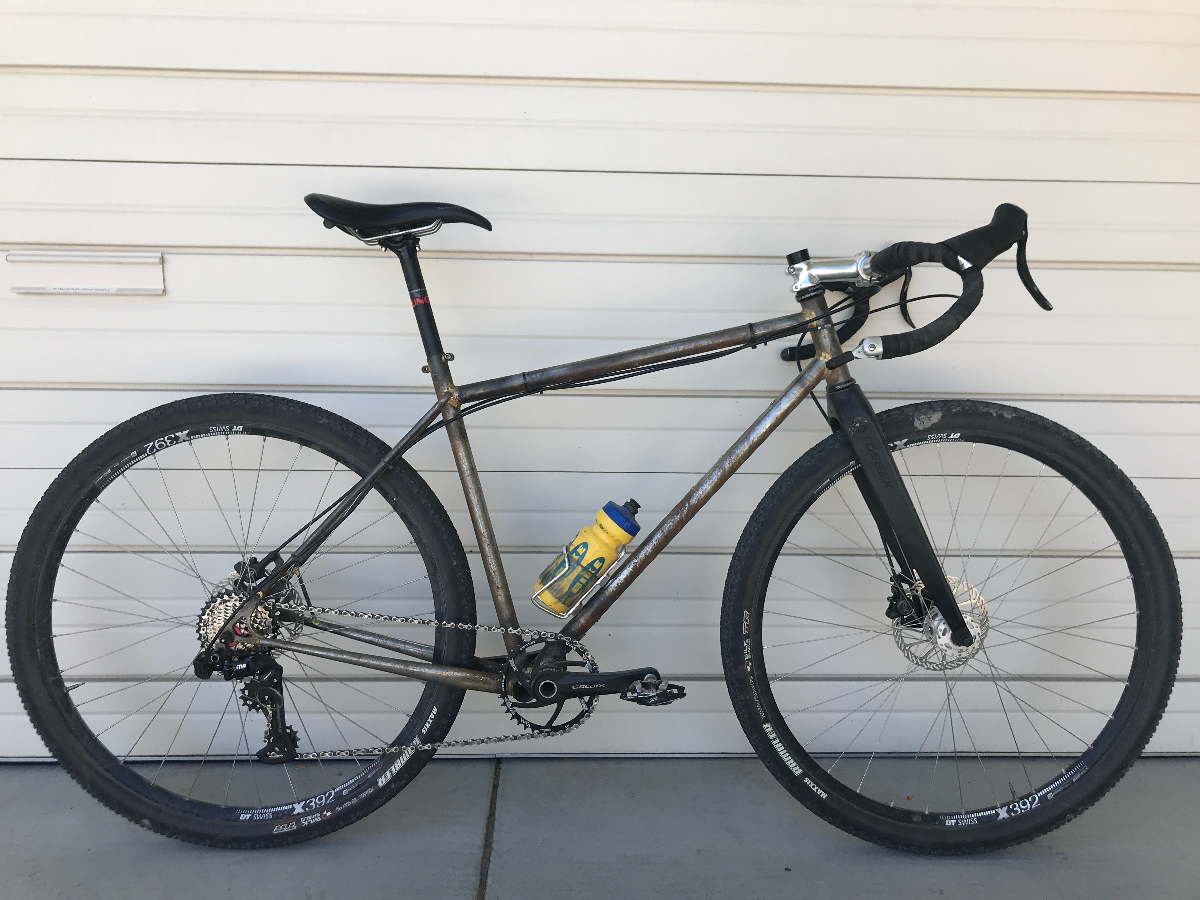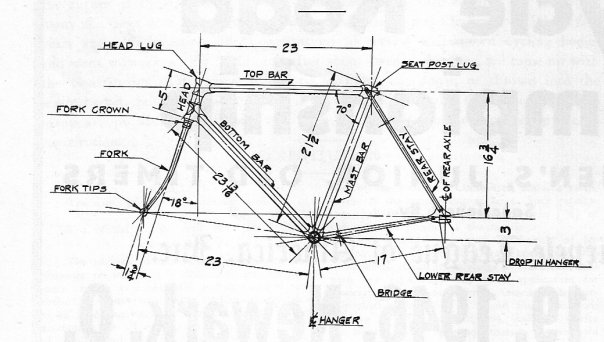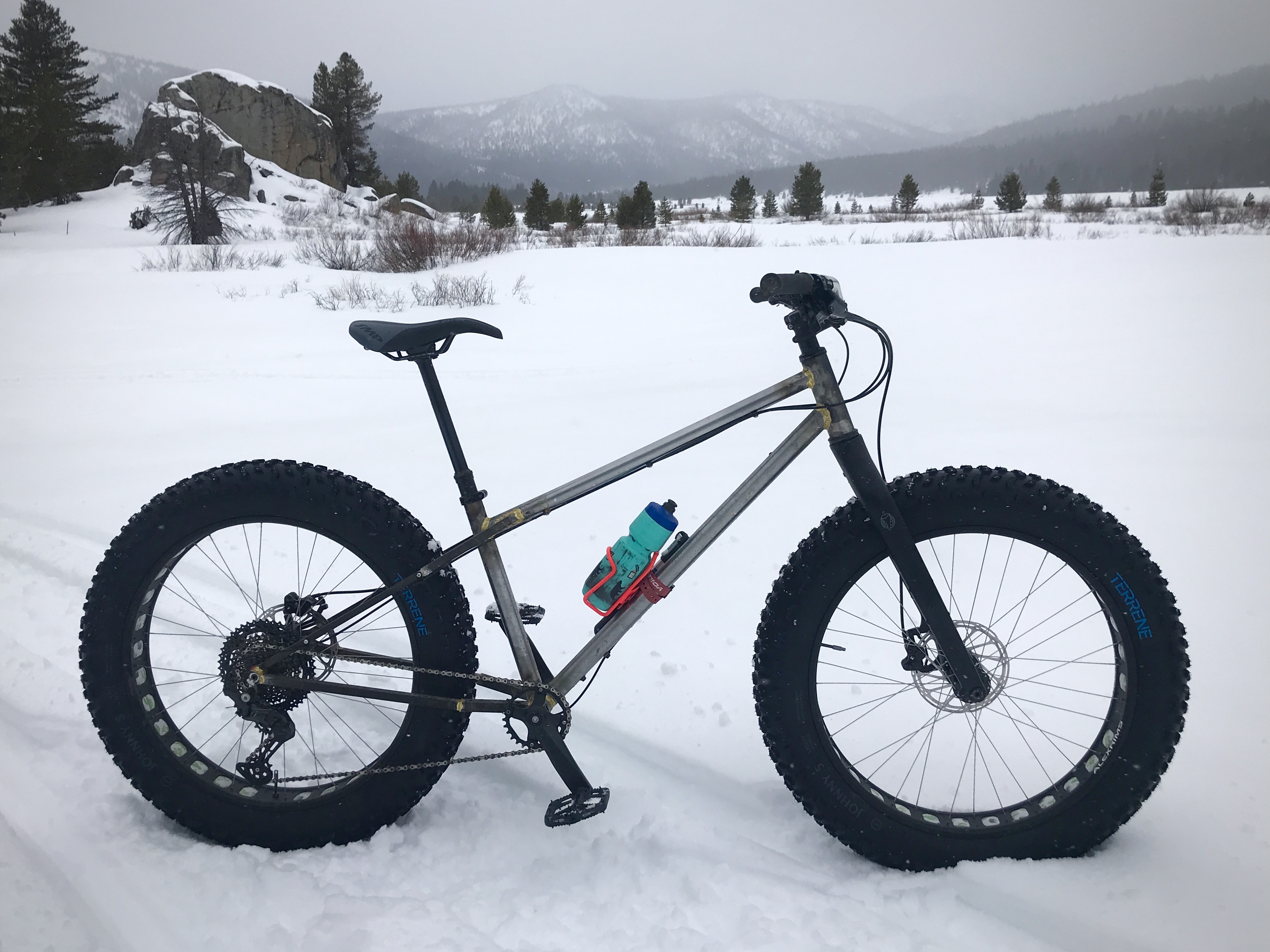Bike Check: SC-1
Here's a closer look at "SC-1" the first bike in my "short crank" series. I also contrast it to my previous gravel frame which give a bit more context to the geometry changes that are going into the SC series.
This frame was originally #14, built in 2019. Progressive mountain bike geometry was starting to be a thing so I was thinking about a gravel frame that would go in similar directions. However, a long front center and short stays didn't have any purpose for a bike that was mostly going to be grinding out flat miles in the wind. Steeper seat tube and slacker head angle also sort of leaned towards time trial bikes so what I ended up with was 74/70 geometry. Stays were extended to 447 to get more stability and a smoother ride. When trying to hold a low position I didn't want to keep getting bucked by short stays. Unlike previous bikes that were more in the touring/rando vein, this one had me thinking more about power and aerodynamics.

I was also interested in being able to run some of the super fast XC race tires, so I built it around a very cheap Toseek 26" carbon disc fork with a 420mm axle to crown. The fork also had an old-school 38mm offset adding more trail to the front end. Initially I built it up with Soma Supple Vitesse 48s which like other Panaracer tires were a disaster to run tubeless. Later they were swapped for Schwalbe Thunder Burt Liteskins which are just as fast and supple, but don't weep sealant like a sponge and have beads that don't stretch out after one mounting.
Since the bike was designed for big tires and grinding out miles on Midwest farm roads I gave it a road bike bottom bracket height. I think it was a least 90mm of drop. This was fine for graded dirt roads but later ended up being a little on the low side.
The rest of the initial build stayed fairly road oriented with a 8 speed Shimergo drivetrain and a 30-44 94BCD cranks. Brakes are the woefully underrated Hayes CX. An oddball SRAM disc brake dynamo hub (manufactured by Panasonic) wrapped up the interesting parts choices.
After the bike left the plains for the Sierra, it transformed into various underbiking forms. At one point I had a taller 440mm fork to slack it out a little more, 1x drivetrain, wide PNW drop bar, a dropper, and Cushcores on it. I rode it like an idiot for a summer but after 2023's endless winter I wanted something I could ride on the road more while the trails thawed out.
It was replaced by #22 which was built around some bargain 650b carbon wheels. This bike shorted the chainstays to 420 to get the bike a little peppier in the local hills, The head angle was steepened to 71.5 and paired with a 50mm offset fork the front end flop was reduced so the bike would feel with narrower bars when out of the saddle. The reach was also shortened slightly to keep the weight distribution and keep the stem lengths more around 90-100mm. Bottom bracket was moved back up to get some more pedal clearance.

Taking inspiration from recent MTB builds, the frame uses a Super Boost rear hub for a better 1X chainline. In front was a 175mm SLX crankset since I don't like low Q cranks, spinning on a custom 44 x 92mm bottom bracket shell so I could use head tube stock and reamers. Ltwoo GR-9 shifters are actually pretty decent, especially if you like your brake lever to not move but can't get used to SRAM Double Tap. The matching GR-9 rear derailleur on the other hand was a piece of junk. The top pivot developed a large amount of play in only a couple rides. The overall design was also deeply flawed in that they tried to recycle a MTB pull rear derailleur with a different shifting arm but didn't change the direction the cable stop points. This meant an insane amount of friction in the low gears. This is the reason Trace Velo had such a hard time with them. The GR-9s are Shimano road 11 pull so I could have paired them with a GRX model, but I decided to try the Sride 520C overlength rear derailleur. This is the ultimate mullet derailleur - road pull, tons of capacity, can clear massive cogs, and clutched. Though it doesn't look terribly high dollar, it still shifts as well as the day I put it on. It's not a mindblowing drivetrain but it all "just works" without too much fanfare.
Frame #22 was a real success, but then the crank experiments and fit epiphanies happened. #14 came out and got a second bottom bracket to compensate for the 155s. I like to think of by bikes as fitting "series", so #14 is now "SC-1".
The initial build was chaos, untrimmed TRP Hylex brakes, an old Suntour barcon, Sunrace MX-600 rear derailleur shifting an 11 speed cassette (a setup that does work!). After a few months I was enjoying the 155s enough to give them a full year, so I stole parts off the now retired #22 to get back the Ltwoo shifters. The plasticky indestructible SMP Well went to my fat bike and the fancier leather SMP Nymber moved in. As I detailed in the Crankarm Chronicles, I didn't gear down and I don't think I will.

As for the numbers, what changed?
- Seat angle is ~71, from 74
- Chainstays are 485, from 447
- Stem length has trended about 10mm shorter
- Bottom bracket is a little higher since I attached the BB shell directly to the down tube.
Pros
- Position is balanced and centered
- Cornering is planted and intuitive
- Very little load on my hands
- Seated power is incredible
- Can get tiny and it at least feels more aero
- Glute focus seems to make for more endurance
- Seated position can be more stretched
- Standing position is shorter and more controllable
Cons
- Harder to cruise at a low effort, though I seem to be slowly adapting
- Gears seem to bog down sometimes
- Transition out of the saddle takes longer, like getting out of a Lazy Boy
- Bars can be set up too low making standing cramped.
I'm going to stick with the 155s for now to see if I there's further adaptation to be had. I may also cut down some cranks to 145s to see what even shorter does and which of the pros and cons get better or worse.
At some point I'll build a new frame that mixes SC-1 and #22. It will have a 71 seat angle an long stays from SC-1, reach will be closer to #22 as will the front geometry to get a little less flop than SC-1. It will take bigger tires than SC-1 and #22 so I can run some of the fast XC racing tires in their slightly wider current sizes. I'm considering shortening the stays because by the numbers seem absurd, but they don't feel long in practice so maybe I'll leave them. I really should double-check the weight distribution.

My early CAD designs for the this bike remind me of old British path racers, such as this 1946 Blue Riband. Here you see the slack seat angle and long stays. I don't have any good insight on why these bikes were built so slack. At least there is a good selection of bikes in collector's hands to get a broader sense of the range of numbers.
It also seems to have some things in common with old six-day bikes like this bike built for Willie Honeman by Pop Brenner in 1932 (see the Classic Cycle Museum page for more). Here I could theorize that in six-day racing you need something comfortable where you can grind out lots of miles and this makes sense with shifting the muscle loads to the glutes. But unlike path racers, there's not a lot of six-day bikes to look at so I don't want to get too latched into this example, as it also could have been Honeman's personal preference. Blogger and gravel guru Guitar Ted recently had a custom built taking inspiration from Honeman's bike so it will be interesting to see how it works for him.

Also many of these old bikes have seats that are positioned further forwards than today's bikes, so that might make the slack seat angle less relevant than it seems. So we should be cautious when trying to make the seat angle mean something about position.
I'd like to build some trail focused frames with short crank geometry since now they all feel wrong, but with a late winter finally arriving the SC-2 ended up being a new fat bike. So far it feels great. It has that same refined feeling when you sit on it. It's a lot more balanced than my previous bike and it's easy to shift your weight around to move weight between the wheels as needed.

So in all likelihood the new gravel frame will be SC-3. SC-4 looks to be a new trail bike that will based on my previous fatbike wheels but use narrower cranks for more pedal clearance in the corners.